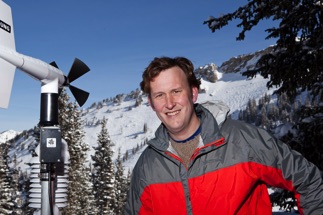Tim Garrett

Education
University of Washington, Ph.D., Atmospheric Sciences, 2000
University of Washington, M.S. Atmospheric Sciences, 1995
University of Waterloo, B.Sc. Honours Physics, 1992
Prior positions
Associate Professor, Atmospheric Sciences, University of Utah, 2008 - 2014
Co-Founder, Particle Flux Analytics, 2015 - present
Co-Founder and President, Fallgatter Technologies, 2011 - 2015
Visiting Professor, Université de Lille I, France, 2008 - 2009, 2016-2017
Visiting Professor, Université Blaise-Pascal II, France, 2013
Assistant Professor, Meteorology, University of Utah, 2002 - 2008
Huber Fellow, Princeton Environmental Institute, Princeton University, 2000 - 2002
Activities
My research focus is the physics of clouds. Clouds and precipitation are interesting because they display such an extraordinarily wide range of interactive physical processes requiring understanding of both specific processes and constrained system behaviors. Understanding these is critical for improving weather and climate forecasts.
I also develop simple physical models for describing civilization growth. While clouds and economics may seem disconnected, both are complex systems that evolve according to non-equilibrium thermodynamic rules.
Much of this work is done in collaboration with graduate students in the ACCS group using a broad mixture of pencil and paper, numerical computation, laboratory, and field studies. We also design and build instruments for study of snowflakes and make them available to researchers worldwide through start-up company Particle Flux Analytics.
When not doing research, I teach graduate and undergraduate classes in Cloud Physics, Atmospheric Radiation and Thermodynamics, and I serve as a co-editor for the Copernicus open access journal Atmospheric Chemistry and Physics.
Open Ph.D. position
A position is open in the Department of Atmospheric Sciences to study the observational and theoretical aspects of the response of falling precipitation particles to turbulent air. How fast snow falls has been identified as one of the key sensitivities in weather and climate predictions, but no models yet account for how snow swirls. A graduate student will collect field data and use numerical simulations to help solve this critical problem.
Recent grant funding
UK Economic and Social Research Council: Integrating macroeconomics and ecology via energy and the Laws of Thermodynamics
DOE: Parameterization of arctic hydrometeor physics using new precipitationmeasurement technologies.
DOE STTR Phase II: High Temporal and spatial measurement of hydrometeor mass for automated assessment of precipitation rate and type.
NSF Observational and theoretical investigations related to hydrometeor settling in turbulent air.
Select Publications
Analytical Estimation of the Widths of Hadley Cells in the Solar System Astrophys. J.
Analytical Solutions for Precipitation Size Distributions at Steady State J. Atmos. Sci.
Thermodynamic constraints on the size distributions of tropical clouds J. Geophys. Res. Media coverage
High Sensitivity of Arctic Liquid Clouds to LongRange Anthropogenic Aerosol Transport Geophys. Res. Lett. Media coverage
Effect of long-range aerosol transport on the microphysical properties of low-level liquid clouds in the Arctic. Atmospheric Chemistry and Physics
Long-run evolution of the global economy II: Hindcasts of innovation and growth Earth System Dynamics
Observed influence of riming, temperature, and turbulence on the fallspeed of solid precipitation Geophys. Res. Lett.
Long-run evolution of the global economy Part I: Physical basis Earth’s Future
Ground based remote sensing of thin clouds in the Arctic. Atmos. Meas. Tech. 2013
Can we predict long-run economic growth? Retirement Management Journal, 2012 Media coverage
A simple framework for the dynamic response of cirrus clouds to local diabatic radiative heating J. Atmos. Sci. 2012
Fallspeed measurement and high-resolution multi-angle photography of hydrometeors in freefall. Atmos. Meas. Tech. Media coverage
Modes of Growth in Dynamic Systems Proc. Roy. Soc. A, 2012
No way out? The double-bind in seeking global prosperity alongside mitigated climate change, Earth System Dynamics, 2012
The role of scavenging in the seasonal transport of black carbon and sulfate to the Arctic, Geophys. Res. Lett., 2011 Media coverage
Space-based evaluation of interactions between aerosols and low-level Arctic clouds during the Spring and Summer of 2008 Atmos. Chem. Phys., 2011
Are there basic physical constraints on future anthropogenic emissions of carbon dioxide? Climatic Change, 2011. DISCUSSION CRITICISMS Media coverage
Mammatus clouds as a response to cloud base radiative heating J. Atmos. Sci. , 2010
An evolving history of Arctic aerosols. Bull. Amer. Meteorol. Soc., 2008 Media coverage
Comments on "Effective radius of ice cloud particle populations derived from aircraft probes" J. Atmos. Oceanic. Technol., 2007
Increased Arctic cloud longwave emissivity associated with pollution from mid-latitudes. Nature, 2006 PRESS
Convective formation of pileus cloud near the tropopause Atmos. Chem. Phys. 2006
Evolution of a Florida cirrus anvil, J. Atmos. Sci., 2005
Small, highly reflective ice crystals in low-latitude cirrus. Geophys. Res. Lett., 2003 Media coverage